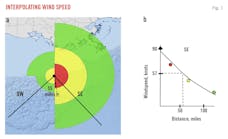Study: North Texas quakes likely linked to gas drilling
A seismology team in a study led by Southern Methodist University found high volumes of wastewater injection combined with brine extraction from natural gas wells was “the most likely” cause of earthquakes near Azle, Tex., during 2013-14.
In an area where the seismology team identified two intersecting faults, they developed a 3D model to assess the changing fluid pressure within a rock formation in the affected area. They used the model to estimate stress changes induced in the area by two wastewater injection wells and more than 70 gas wells.
“The model shows that a pressure differential develops along one of the faults as a combined result of high fluid injection rates to the west and high water removal rates to the east,” said Matthew Hornbach, SMU associate professor of geophysics.
“When we ran the model over a 10-year period through a wide range of parameters, it predicted pressure changes significant enough to trigger earthquakes on faults that are already stressed.”
Heather DeShon, SMU associate professor of geophysics, said induced seismicity–earthquakes caused by something other than strictly natural forces–is often associated with subsurface pressure changes.
“We can rule out stress changes induced by local water table changes,” DeShon said. “While some uncertainties remain, it is unlikely that natural increases to tectonic stresses led to these events.”
While the SMU Azle study added to evidence connecting some injection wells and, to a lesser extent, some oil and gas production to induced earthquakes, SMU’s team noted many thousands of injection and production wells are not associated with earthquakes.
The study, “Causal Factors for Seismicity near Azle, Texas,” was published Apr. 21 in the journal Nature Communications.
Hornbach and DeShon were the lead authors of the study, which was produced by a team of scientists from SMU, the US Geological Survey, the University of Texas Institute for Geophysics, and the UT Department of Petroleum and Geosystems Engineering.
SMU seismologists have been studying earthquakes in North Texas since 2008, when tremors hit near the Dallas-Fort Worth International Airport during 2008-09. A series of quakes was reported in Cleburne during 2009-10. Quakes in Azle-Reno area northwest of Fort Worth occurred 2013-14.
The SMU team also is studying an ongoing series of earthquakes in the Irving-Dallas area that began in April 2014.
Contact Paula Dittrick at [email protected].
*Paula Dittrick is editor of OGJ’s Unconventional Oil & Gas Report.

Paula Dittrick | Senior Staff Writer
Paula Dittrick has covered oil and gas from Houston for more than 20 years. Starting in May 2007, she developed a health, safety, and environment beat for Oil & Gas Journal. Dittrick is familiar with the industry’s financial aspects. She also monitors issues associated with carbon sequestration and renewable energy.
Dittrick joined OGJ in February 2001. Previously, she worked for Dow Jones and United Press International. She began writing about oil and gas as UPI’s West Texas bureau chief during the 1980s. She earned a Bachelor’s of Science degree in journalism from the University of Nebraska in 1974.
